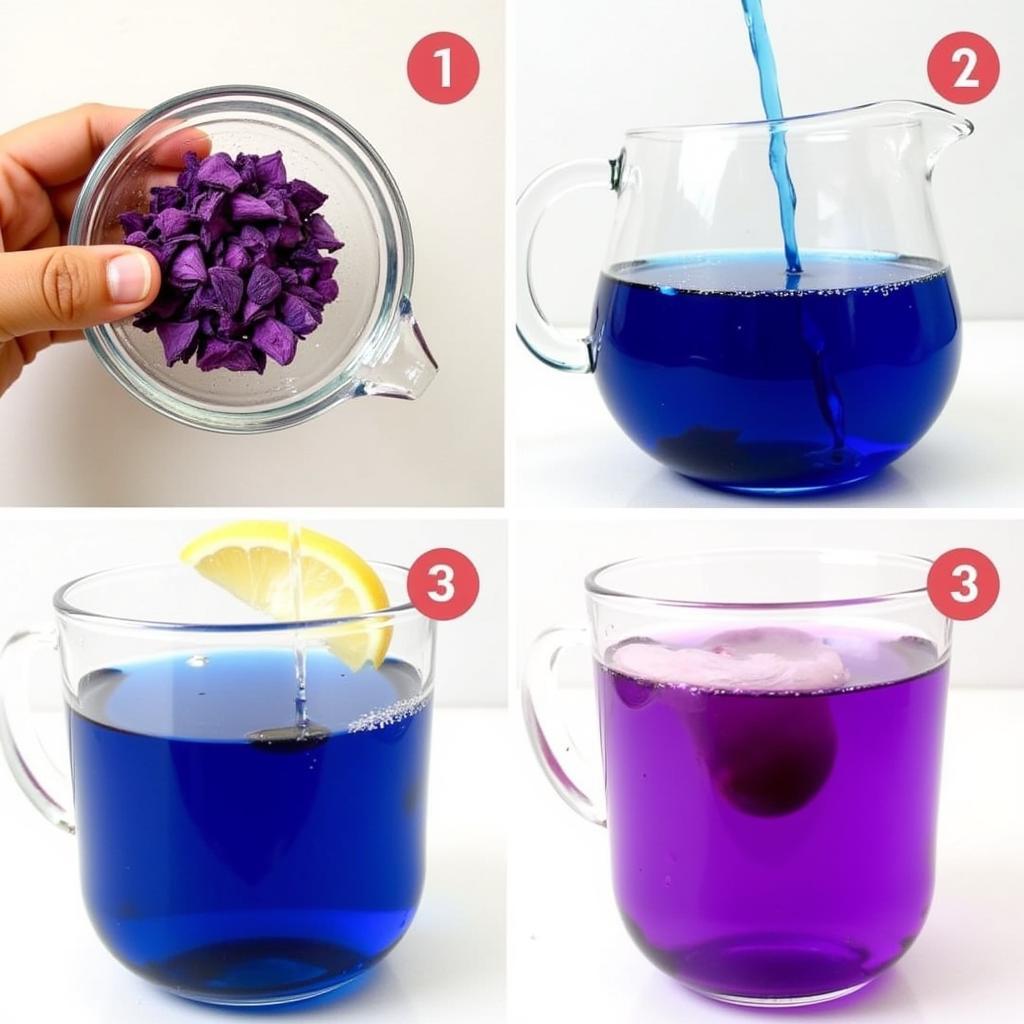Butterfly pea tea, also known as blue tea, is a vibrant, caffeine-free beverage known for its mesmerizing color-changing properties. But why does this beautiful blue liquid transform so dramatically with the addition of a simple ingredient like lemon juice? The secret lies in the pH-sensitive anthocyanins present in the butterfly pea flower. Let’s delve into the science behind this fascinating phenomenon.
The captivating blue hue of butterfly pea tea comes from anthocyanins, a group of water-soluble pigments found in many plants, including blueberries, grapes, and red cabbage. These pigments are responsible for a range of colors from red and purple to blue, depending on the pH level of the environment they’re in. In the case of butterfly pea tea, the naturally alkaline nature of the brewed flowers results in the beautiful blue color we see.
The Science Behind the Color Change
The magic happens when you introduce an acidic substance, like lemon juice, to the tea. The addition of acid lowers the pH of the tea, causing the anthocyanins to shift their structure. This structural change alters the way the pigments absorb and reflect light, resulting in a dramatic color transformation from blue to vibrant purple or even a striking pink. It’s a visual representation of a simple chemical reaction, making butterfly pea tea a fun and educational drink. After the initial blue, the exact shade of pink or purple depends on the concentration of acid added. More acid leads to a more intense pink hue.
Have you ever wondered what color tea typically is? Check out this interesting article: what color is tea.
Exploring the pH Spectrum with Butterfly Pea Tea
The pH scale, which ranges from 0 to 14, measures the acidity or alkalinity of a substance. A pH of 7 is considered neutral, while values below 7 are acidic and values above 7 are alkaline. Butterfly pea tea provides a captivating visual demonstration of this scale. By adding different ingredients with varying pH levels, you can create a rainbow of colors in your cup. For example, a pinch of baking soda, which is alkaline, will intensify the blue hue. Conversely, adding a few drops of vinegar, which is highly acidic, will transform the blue to a deep pink.
 Butterfly Pea Tea Color Change with Different pH Levels
Butterfly Pea Tea Color Change with Different pH Levels
Why is this Color Change Important?
Beyond its aesthetic appeal, the color-changing property of butterfly pea tea has practical implications. It can be used as a natural pH indicator in cooking and science experiments. Furthermore, anthocyanins are powerful antioxidants, which are beneficial for health. So, not only is butterfly pea tea a delightful sensory experience, but it also offers potential health benefits. However, more research is needed to fully understand the extent of these benefits.
Can insects perceive these color changes as vividly as we do? For instance, can flies see the color red? Learn more about insect vision: can flies see the color red.
How to Make Color-Changing Butterfly Pea Tea
Making this enchanting tea is simple. Steep dried butterfly pea flowers in hot water for about 5-10 minutes. The water will turn a deep blue. Once brewed, you can add lemon juice, lime juice, or any other acidic ingredient to witness the magical color transformation. Experiment with different ingredients and observe the resulting hues! You can even freeze the tea into ice cubes and add them to other beverages for a surprising burst of color.
 Preparing Butterfly Pea Tea and Observing the Color Change
Preparing Butterfly Pea Tea and Observing the Color Change
Conclusion
The captivating color change of butterfly pea tea is a result of the pH-sensitive anthocyanins reacting to changes in acidity. This natural phenomenon not only makes for a visually stunning beverage but also serves as a reminder of the fascinating chemistry present in everyday life. So, the next time you enjoy a cup of this mesmerizing tea, remember the science behind its magical transformation.
FAQ
- Is butterfly pea tea caffeinated? No, butterfly pea tea is naturally caffeine-free.
- Where can I buy butterfly pea flowers? You can find dried butterfly pea flowers online, in specialty tea shops, or in some health food stores.
- Does butterfly pea tea have any taste? Butterfly pea tea has a subtle, slightly earthy flavor. Some describe it as mildly sweet.
- Can I add sugar to butterfly pea tea? Yes, you can add sugar or other sweeteners to adjust the taste to your preference.
- How long can I store brewed butterfly pea tea? It’s best to consume brewed butterfly pea tea within a day or two for optimal flavor and color.
- Are there any known side effects of drinking butterfly pea tea? Butterfly pea tea is generally considered safe for consumption. However, it’s always best to consult with your doctor before adding any new herbal teas to your diet, especially if you are pregnant, breastfeeding, or have any underlying health conditions.
- Can children drink butterfly pea tea? While generally safe, it’s recommended to consult a pediatrician before giving butterfly pea tea to young children.
Do you know the colors of your favorite cartoon characters? Find out what color is shimmer and shine.
Need more information about color and design? Contact us at Phone Number: 0373298888, Email: [email protected] or visit us at 86 Cau Giay, Hanoi. We have a 24/7 customer service team ready to assist you.

